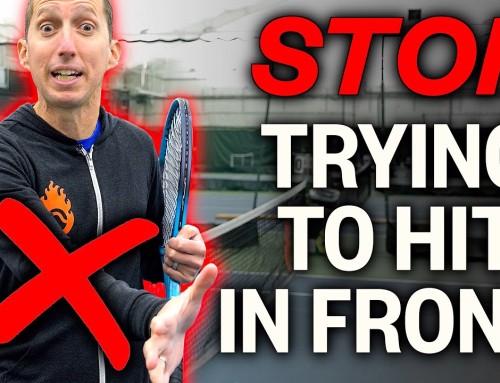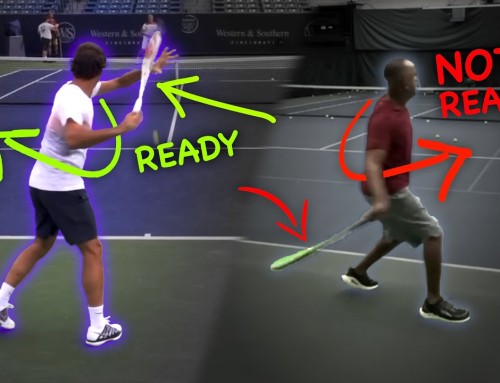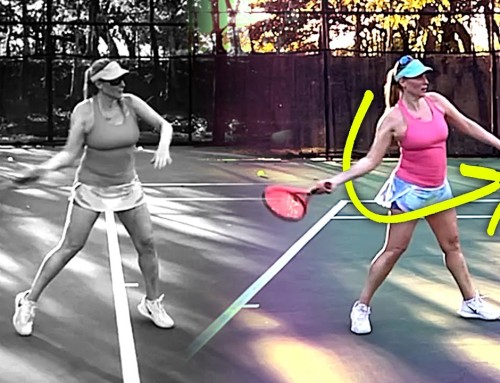If you’ve ever felt like your forehand lacks punch or penetration, even when you’re swinging hard, then this lesson is going to be eye opening for you.
I was recently working with a student on this exact problem and what we discovered on video was pretty revealing.
She wanted more drive through the ball. More pace. More depth. All the good stuff that makes a forehand dangerous.
But here’s what was actually happening.
She was setting up in an open stance, which is totally fine by the way, but her preparation was killing her power before she even swung.
Let me explain what I mean.
When you watch professional players hit from an open stance, something really important happens before they ever make contact with the ball. Their hips turn close to perpendicular with the baseline and their shoulders rotate even further past that.
This creates stored energy that they can unwind through the shot.
Think of it like coiling a spring. The more you wind it up, the more force it can release.
My student was setting up with her hips and shoulders basically even with each other, barely turned at all. That means all the responsibility for generating pace was falling on her arm.
The small parts were doing all the work because the big parts weren’t loaded up in the first place.
And you know what happens when you try to muscle the ball with just your arm? You get that weak, spinny shot that floats instead of drives. Or your contact point drifts too far back behind your body because your rotation never happened early enough.
Sound familiar?
Here’s the thing about open stance forehands that most players don’t understand.
A lot of coaches will yell at you to step in when they see you hitting weak shots from an open stance. They think the stance itself is the problem.
But whether you’re stepping in or staying open, your body still needs to coil first. The turn has to happen regardless of your footwork.
You can hit a monster forehand from an open stance. You just have to use your body correctly within that stance.
So here’s what we worked on.
We started in the middle of the service line and practiced going from ready position to a fully coiled preparation position. Hips as close to perpendicular as possible. Shoulders at least perpendicular, ideally a little bit past the hips.
Just that change alone made a massive visual difference.
When I showed her the before and after, even she could see it. One position looked intense and loaded with potential energy. The other looked flat and reliant on the arm.
Which one do you think is going to produce more penetrating shots?
We practiced the coil by itself. Then slowly added the forward swing. Then started hitting actual balls.
And you know what? The difference was dramatic.
Same swing speed, same effort level, but now the ball was driving through the court instead of arcing weakly over the net. Now there was a long runway for the racket to accelerate through instead of a short, cramped swing path.
The power was coming from rotation instead of arm strength.
Here’s what I want you to take away from this.
If you prefer hitting from an open stance, that’s completely fine. I have no problem with it at all, as long as it’s not the only way you can hit and you’re using it in the right situations.
But you’ve got to use your body effectively within that stance.
Your hips need to get to 90 degrees. Your shoulders need to turn past your hips. This is what creates the stored energy that unwinds through the shot and produces real, penetrating pace.
Without that coil, you’re just asking your arm to do way too much work.
And your arm simply isn’t strong enough to consistently hit the kind of forehand you’re envisioning.
The biggest challenge when you go home to practice this? Your subconscious is going to want to revert back to your old habit, especially when things get more real in a point or a match.
You’ll do beautiful shadow swings with perfect coil and rotation. Then as soon as you start tracking a moving ball, your old program kicks in and the shoulders barely turn.
This is totally normal. It happens to everyone.
The solution is being disciplined enough to keep coming back to the feel of that coiled position, even when it feels awkward or different at first.
Your body wants to run the old forehand program because it’s familiar and comfortable.
Your job is to override that and install the new program through repetition.
Every little bit extra you can squeeze out of your hip and shoulder rotation is going to make your swing that much stronger. Five more degrees here, ten more degrees there. It all adds up to a more athletic, more powerful position.
And here’s the beautiful part.
When you actually coil properly, you don’t have to swing any harder. The ball just naturally drives deeper and flatter because the path of your racket is mostly forward with just a little bit of low to high.
You’re not spinning it wildly over. You’re driving through it with the force of your entire body unwinding.
That’s what a real forehand feels like.
Give this a try and let me know how it goes for you.
Yours Truly,
Ian







